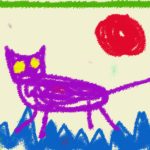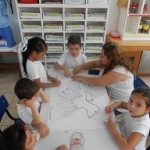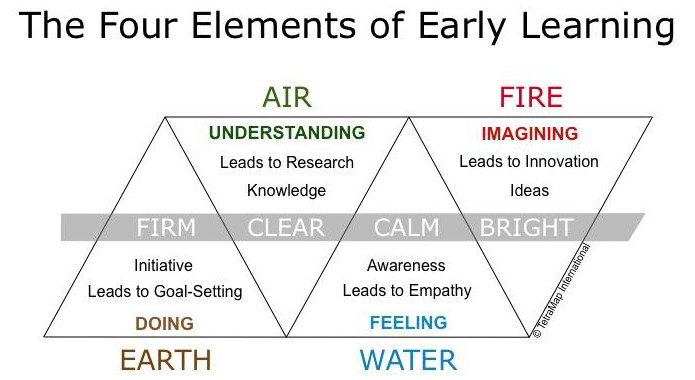The four Elements of early learning
by Renee Rainville
How can youth reach their full potential?
This is an area that Renee Rainville, an experienced educator and Certified TetraMap Facilitator, has been dedicating much learning and study to over the past four years since being introduced to TetraMap. TetraMap is a versatile methodology that can be applied practically in a variety of situations, and Renee has used it as a sustainable answer to maintaining creativity in youth.
In this guest article, Renee explains how to better capture and encourage creativity in early childhood education using TetraMap and how to apply it in the classroom.
TetraMap applications in early childhood

Curiosity and creativity exist inherently in every child. These two characteristics make up the engine that drives all four Elements during the early childhood years. Yet according to a Create Study by Adobe, only 1 in 4 adults feel that they are living up to their creative potential. 59% of 5000 people surveyed in US, UK, France, Germany, and Japan attribute this to educational systems that stifle creative learning and problem-solving.
Curiosity allows us to absorb what we feel, see, hear, taste, and smell. In the very young these are the building blocks of information for our organised, knowledge-based Air Element as well as the feeling-based Element of Water.
Creativity allows us to assimilate and encode this information within a scheme of infinite possibilities that we encounter within our Fire Element. Without creativity, risk-taking found in our Earth Element becomes more difficult as the brain loses its plasticity to imagine all potential solutions, benefits, and drawbacks in adulthood.
Reigniting innovative possibilities: using TetraMap as a sustainable answer to maintaining creative development
 In early life, the first word many children hear is “no”. Not questions like “What does that feel like? What do you hear? Do you like that taste?” It sounds more like “Don’t touch that! Stop that banging! Get that out of your mouth!” Each no brings curiosity into check, leading to the realisation at a young age that curiosity is undesirable by the surrounding adults a child looks up to and cherishes. This lowering of curiosity brings a lowering of knowledge acquisition as exposure to stimuli is lessened. The effect in later life on creative problem solving and 21st-century skills can be devastating to a sustainable world.
In early life, the first word many children hear is “no”. Not questions like “What does that feel like? What do you hear? Do you like that taste?” It sounds more like “Don’t touch that! Stop that banging! Get that out of your mouth!” Each no brings curiosity into check, leading to the realisation at a young age that curiosity is undesirable by the surrounding adults a child looks up to and cherishes. This lowering of curiosity brings a lowering of knowledge acquisition as exposure to stimuli is lessened. The effect in later life on creative problem solving and 21st-century skills can be devastating to a sustainable world.
Our creative mind takes the information our senses give us and it begins to categorise and compare. A child sees the sun as red, the grass as blue, and the dog as a cat. And what are they told? The sun is yellow, the grass is green and the dog makes the sound bow-wow. Slowly the limitless possibilities of a creative mind are caged within walls. Seeing innovative possibilities diminishes.
TetraMap holds a necessary key for people all over the globe – a language that unites, that permits differences, that highlights similarities, and that creates balance. Early childhood is a constructive stage in awareness development and can be complemented with due importance by adult exposure to TetraMap.
TetraMap as a behavioural tool can be very beneficial to early learning teachers and parents. At first glance, the WAYLT (Why are you like that?) workbook reconnects teachers and parents with their own characteristics. It allows them to remember what each Element feels and looks like. Reconnecting with balance in oneself can then be transcribed into developing balance in the young children in their care. We must remember that most adults repressed their own curiosity and creativity in early childhood as a reaction to adults around them and they must be reawakened through TetraMap Elements.
Recognising early signs of Elemental preferences
Even parents of very young children (1-2 years old) can identify in their child which TetraMap Element seems to be most prominent with no exposure to the tool itself – a tribute to its raw, organic nature.
These children are described easily by their parents:
- My child is strong-willed; she wants her own way.
- My child is a dreamer, always off in his own world.
- My child is very social; I worry that there is no fear of strangers.
- My child is cautious; he gets anxious if I don’t explain things to him before they happen.
Teachers and school principals who practise TetraMap can listen for these tell-tale signs of potential Element preference. This information can help the preschool teacher know how to approach this child in the class, how to respond to them, motivate them, and catalyse the development of the other three Elements and provide experiences where they can use all 4 Elements naturally.
Creating a curriculum around the TetraMap Elements ensures a balanced child. The first weeks of school are dedicated to knowing the students and establishing expectations.
Imagine a classroom where the activities are Element-focused
On the first day of school, the teacher can create centres, one for each Element. This can help the teacher observe each student using skills and then create a personalised plan of action. It is never too early to develop communication and organisation skills.
For instance, a teacher can set up the same activity with small variations to focus each Element, e.g.: Explore your face.
![]() Earth
Earth
Look in the mirror. Point to your eyes, nose, mouth, ears, cheeks, forehead. Trace your face.
In this activity the students DO. They are active and working toward an objective of identifying parts of their face. Some children have difficulty making decisions and exploring by doing opens up the path toward goal setting.
![]() Air
Air
How many eyes? How many noses? How many ears? How many mouths? Where do you see a circle? Where do you see a triangle? What is above your mouth? What is below your nose? What do you hear with? etc.
Here students are developing an understanding of their face, the parts on it, the names and the functions. This knowledge can later be used to imagine.
![]() Water
Water
Each time a student is expressing an emotion the teacher names it. If she can, she has the child see his face in the mirror. It is important that this activity be genuine. The Water Element is about true feeling. The very young must first recognise feelings in themselves before they can recognise them in others and develop empathy. “Teacher, Michael is sad. He is crying.”
![]() Fire
Fire
Have all types of coloured and textured paper and different drawing materials available for the students. Ask them to draw their face with or without looking in the mirror. Allow the student to explain when they are done what they have drawn and asked them why they chose that colour and that drawing utensil. All answers are accepted. Being able to see your face as blue keeps the possibility open later that there is nothing “wrong” about not seeing things the way others do.
Applying TetraMap to giving balanced instructions to children
Even giving instructions can be guided by the TetraMap tool. Each time an instruction is given, it should be done taking into account each type of communication style.
For example, a preschool teacher is about to start a fun activity where three live animals have been brought in for show and tell. A teacher can do a pre-planning and brainstorm how each Element might react to the presence of the animals in the room.
 Children with a high Air Element may show fear, not knowing what to expect.
Children with a high Air Element may show fear, not knowing what to expect.- Children with high Fire Element will show excitement and rush on the animals.
- Children with high Earth Element will want to know why the animals are in the room.
- Children with high Water Element will want to pet the animals and take care of them.
To make this activity run smoothly, the teacher can begin the lesson before the animals are brought in pre-empting potential chaos.
She starts by putting the children in a circle and showing a picture of each of the animals that will be brought in.
- “Who can tell me what this animal is?” (Air)
- “These animals are going to visit us today in the classroom so we can see how their faces look compared to ours.” (Earth)
- Allow the students to express excitement and ask questions. (Fire)
- “The animals are not used to being around so many people. How do you think the animals might feel?” (Water)
- “I know you may want to touch the animals.” (Fire)
- “We will do this from our sitting positions so the animals do not get scared. (Air) If you stand up, you will not be able to pet the animal (Air) and you may feel disappointed.” (Water)
- “Remember to look at their faces without touching. If you poke the animal in the face, it may feel hurt.” (Water)
- “You can stroke the animal’s back gently. Let’s practise by stroking our arms gently.” (Earth)
- “Are you all ready?” Allow kids to show excitement again before bringing the first animal in. (Fire)
This short introduction makes the activity meaningful to each Element as well as exposing all Elements to all children.
With awareness of the Elements in adults involved in child rearing, be they parents or teachers, even the very young can benefit from the construct of TetraMap. It is of utmost importance to keep alive the curiosity and creativity of us all so that we can move smoothly toward a balanced human environment capable of ensuring sustainable living.
